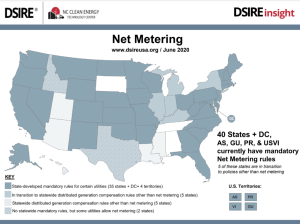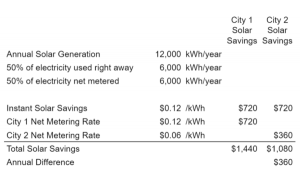As you’re learning in our Solar 101 series, solar power is a combination of construction, hardware… and money.
The money side of things is determined by more than just the cost of construction and hardware. It’s also influenced by the local price of electricity, as well the legal policies governing the power grid. In the United States, these laws vary in every state and are regulated by public utility/service commissions after they’ve been put in place by state legislatures.
One legal structure that gets extensive coverage here in pv magazine USA is “net metering.” It is important to be familiar with net metering because it affects how long your solar project takes to pay for itself, and how you and your contractor need to design your project.
The first thing to know is that net metering is a tool to count and – importantly – assign a value to the excess electricity that a solar project is expected to export to the grid. When the sun is out and your electricity use is low, your rooftop solar will probably produce more energy that you are consuming. That excess power can be routed to the broader electric grid and help reduce the need for large-scale power plants, many of which burn fossil fuels to generate electricity.
Because of net metering, most solar power systems are designed to generate enough electricity in the daytime so that they can offset 24 hours of electricity use. And in order to generate enough electricity to offset use at midnight, a solar system must overproduce at high noon.
So, the electricity utility – following the rules put in place by the PUCs – “meters” (a technical term that describes counting) both your electricity generation and your use. Once the net electricity value has been found, calculations unique to each state determine the dollar value of the net metered electricity; in other words, your system’s net benefit to the grid for which you can be compensated.

One indispensable resource for learning your state’s net metering rules is the N.C. Clean Energy Technology Center’s Database of State Incentives for Renewables & Efficiency (DSIRE for short).
In their net metering law page, you will find links describing policy in 50 states and four territories. DSIRE also provides the summary maps like the one above, providing a cursory view of net metering policies across the U.S.
Again, the laws vary by state. For instance, Florida has a very straightforward law (that the electricity utilities are attacking): all net metered electricity is credited to your electricity bill at the same price that electricity costs to buy. In Utah, the electric utilities successfully lobbied the PUC to lower the rate net metered electricity is paid to well below what homeowners pay. And Hawaii, because it has so much solar power, does not allow homeowners to export electricity to the power grid at all.
Some states, like Texas, have no state-level rules for net metering, despite several utilities that have implemented their own rules.
The nation’s leader in solar power, California, is currently debating what is called “Net Metering 3.0,” a reference to the state’s third major update to its policy. One nuance in California’s current energy policy (NEM 2.0) is that solar system owners are charged for electricity based on “time of use,” while those who do not own solar pay a simple flat rate. That means solar owners pay more for electricity in the evening than in the daytime. This is typically more common in commercial and industrial electricity use cases than in residential.
It also means that residential solar owners in California are paid less for electricity that they produce in the daytime than for electricity they produce in the evening. These policies are intended to motivate consumers to install batteries that store low-cost daytime electricity, to be used or exported during the more expensive peak-demand hours, around 5 PM to 9 PM.
With all that in mind, let’s review the effect net metering has on revenue. Let’s consider two hypothetical cities which have matching electricity rates of 12¢/kWh. In City 1, net metered electricity is paid at a rate matching the cost of electricity – 12¢/kWH. Meanwhile, City 2 pays half of that net metered rate. It looks like this:

As you can see in this example, 50% of our electricity is used instantly inside the home. This offsets the full City 1 local electricity rate of 12¢/kWh. The second 50% is net metered, covering the rest of the City 1 house’s needs during non-sunlight hours.
Meanwhile, City 2’s net metered electricity earns 50% of City 1’s, and, when added to the electricity used instantly, means the project earns 25% less revenue ($360 a year) overall.
In a later article, we will show how net metering laws fit into your project’s economic calculations, and how to calculate your solar power project’s return on investment.






